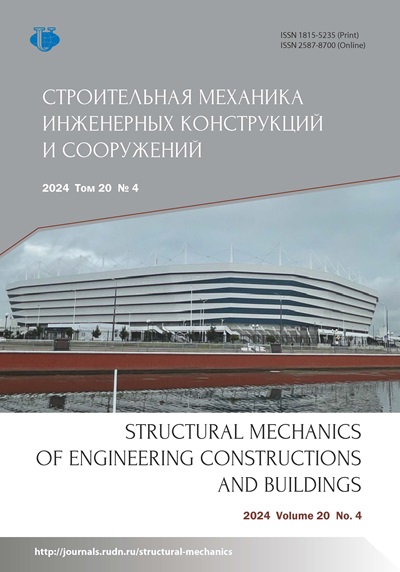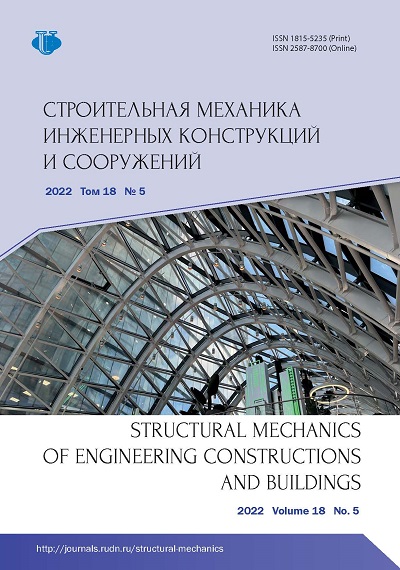Обоснование параметров регулирования усилий сталежелезобетонных пролетных строений разработки ЦНИИПСК «43282 км»
- Авторы: Белуцкий И.Ю.1, Кудрявцев С.А.2, Лазарев И.В.1
-
Учреждения:
- Тихоокеанский государственный университет
- Дальневосточный государственный университет путей сообщения
- Выпуск: Том 18, № 5 (2022)
- Страницы: 407-416
- Раздел: Расчет и проектирование строительных конструкций
- URL: https://journals.rudn.ru/structural-mechanics/article/view/33407
- DOI: https://doi.org/10.22363/1815-5235-2022-18-5-407-416
Цитировать
Полный текст
Аннотация
Сталежелезобетонные пролетные строения в автодорожных мостах стали широко применяться с конца 1950-х гг. в компоновке схем большепролетных мостов, сооружаемых через значительные водные преграды. На сегодняшний день все большую актуальность обретает вопрос необходимости реконструкции отмеченных пролетных строений, в том числе запроектированных и построенных по проекту ЦНИИПСК «43282 км». В исследовании разобраны этапы производства работ конкретного объекта, разработанные для реализации всего комплекса работ по его реконструкции с применением метода регулирования усилий. Представленный порядок выполнения работ успешно реализован на строительстве моста через р. Кабаргу в Приморском крае, что позволило сохранить существующую структуру пролетного строения (главные балки и связи), заменив изношенную железобетонную плиту на новую - металлическую ортотропную, при обеспечении выполнения условий прочности и устойчивости изгибно-крутильной формы сплошностенчатых балок в процессе демонтажа существующей плиты проезжей части и устройства новой. Учитывая, что сталежелезобетонные мосты возводятся через большие водные преграды и в том числе из-за большой длины имеют значительную стоимость, а реконструкция с использованием существующих опор позволяет существенно сократить стоимость строительства, актуальность модернизации существующих сталежелезобетонных пролетных строений является, несомненно, актуальной. На основании предложенных конструктивно-технологических мероприятий возможно проведение и эффективная реализация работ по реконструкции действующих сталежелезобетонных мостов, не в полной мере удовлетворяющих современным требованиям по грузоподъемности и пропускной способности.
Об авторах
Игорь Юрьевич Белуцкий
Тихоокеанский государственный университет
Email: mosttogu@mail.ru
ORCID iD: 0000-0002-3881-2050
доктор технических наук, профессор кафедры автомобильных дорог, Инженерно-строительный институт
Российская Федерация, 680035, Хабаровск, ул. Тихоокеанская, д. 136Сергей Анатольевич Кудрявцев
Дальневосточный государственный университет путей сообщения
Email: mosttogu@mail.ru
ORCID iD: 0000-0001-5414-7567
доктор технических наук, профессор, заведующий кафедрой мостов, тоннелей и подземных сооружений, Институт транспортного строительства
Российская Федерация, 680021, Хабаровск, ул. Серышева, д. 47Игорь Витальевич Лазарев
Тихоокеанский государственный университет
Автор, ответственный за переписку.
Email: lazarev_igor_v@mail.ru
ORCID iD: 0000-0002-4677-7478
кандидат технических наук, доцент кафедры автомобильных дорог, Инженерно-строительный институт
Российская Федерация, 680035, Хабаровск, ул. Тихоокеанская, д. 136Список литературы
- Streletsky N.N. Steel-reinforced concrete bridge spans. 2nd ed., reprint. and add. Moscow: Transport Publ.; 1981. p. 25-82. (In Russ.)
- Gitman E.M. Rational methods of regulation and prestressing of continuous steel-reinforced concrete superstructures using high-strength reinforcement. Studies of Steel and Steel-Reinforced Concrete Bridges. Moscow: Transport Publ.; 1973. p. 45-60. (In Russ.)
- Gitman E.M. Regulation of continuous steel-reinforced concrete span structures and their prestressing without the use of high-strength reinforcement. Constructions, Calculation and Manufacturing Technology of Steel Bridges. Moscow: Transport Publ.; 1974. p. 41-51. (In Russ.)
- Tolmachev K.H. Force regulation in metal superstructures of road bridges (abstract of the dissertation of Doctor of Technical Sciences). Moscow; 1975. (In Russ.)
- Kartopoltsev V.M., Borovikov A.G., Borisenko A.V. Features of the installation of the span structure of the bridge over the Katun River in the village of Askat. Vestnik of Tomsk State University of Architecture and Building. 2004;(1):179-185. (In Russ.)
- Belutskiy I.U., Lazarev I.V., Lapin A.V. The practice of renovating of composite reinforced concrete bridges on restoring their consumer properties. Advanced Science and Technology for highways. 2022;(2):28-34. (In Russ.)
- Belutskiy I.U., Yarmolinskiy A.I., Zhao J., Lazarev I.V. Experience of reconstruction of composite bridges. Advanced Science and Technology for highways. 2016;(3):16-20. (In Russ.)
- Belutsky I.Yu., Lazarev I.V. Improving of special auxiliary structures, devices and technologies associated with reconstruction of steel-reinforced concrete bridges over watercourses. Scientific Works of the Kuban State Technological University. 2022;(1):1-12. (In Russ.)
- Belutsky I.Yu., Zhao J. Structural and layout solutions and modeling of the interface elements of temperature-continuous steel-reinforced concrete span structures. Khabarovsk: Pacific State University Publ.; 2015. (In Russ.)
















